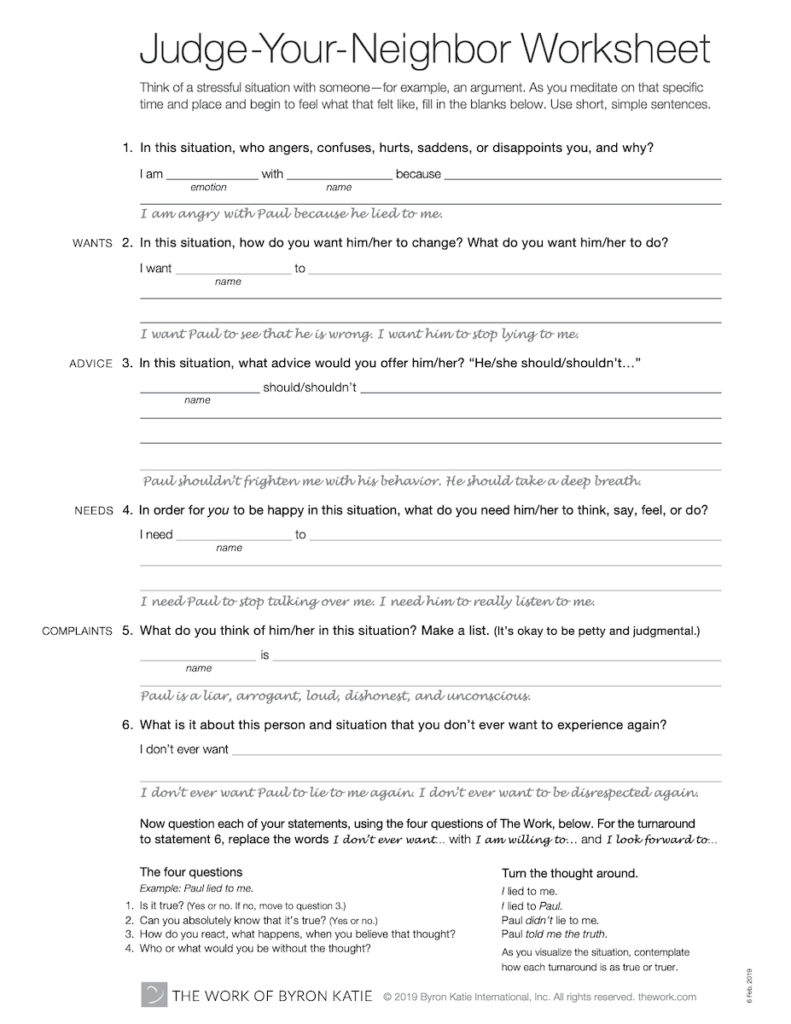Byron Katie is a best-selling author and thought leader famous for her methodology of working with difficult emotions, which she calls “The Work”. She is most famous for this practice, which helps folks who are struggling or seeking greater mental wellbeing identify the root of what is *really* bothering them.
In a climate where many people in the self-help space get put off by strong personalities, Katie’s strategy is refreshing in that it is less linked to her and more about the practice.
Even if you are a seemingly self-aware person, however, her exercises can be super helpful at coaching you to move through uncomfortable periods of life, whether those are periods of obsession, relationship issues, or spiraling thoughts that tend to grip and overwhelm.
(To that end, Katie has worksheets, interviews, and more general archives of her public speaking engagements on her website, The Work of Byron Katie. If you like the mental exercise explained below, feel free to check her out there, as well.)
How To Practice “The Work” by Byron Katie
According to Byron Katie’s methodology, practicing “The Work” involves 4 steps: Notice, Write, Question, and Turn It Around. I’ll summarize these in detail, below.
To get started, here’s an example of a worksheet from Katie that you can use to help you evaluate your emotions when it comes to relationships, disagreements, or judging other people. (She also has downloadable worksheets for teens and kids on her website.)
-
Use This Worksheet (Optional But Recommended)
Screenshot this or download and print it for use at home:

^ This worksheet is also available in several different languages on Katie’s website.
Once you’re settled in with your worksheet, follow the steps below, one by one, to gain more calm and clarity:
Step 1: Notice
Like any mindfulness practice, the first step is to notice what you are feeling. Relax and close your eyes if it helps, and imagine the situation that is upsetting or triggering to you.
Where were you? Who was there? What happened? Be present. How does this make you feel?
Step 2: Write
Using Byron’s worksheet above– or a blank piece of paper, if you prefer, write out the most cogent summary of what you are feeling that you can think of.
Don’t worry about it being “not quite right”. Often, the messiness or ill-fitting description that we write down helps us eliminate variables and gets us closer to what we actually are feeling.
Also: try to use short, simple sentences.
Additionally, try not to judge yourself if what you are feeling is unflattering or ugly. Just be honest and answer the questions on the worksheet to the best of your ability. This practice should help you to eventually arrive at the specific cause of your stress.
Remember: It’s okay to have unflattering thoughts! We all do.
Step 3: Question
Isolate one of your emotions and inspect that feeling. At this point, Byron suggests asking yourself 4 specific questions:
- Is it true?
- Can you absolutely know that it’s true?
- How do you react– e.g. What happens?– when you believe this thought?
- Who would you be without this thought?
Give yourself time to answer. Ultimately, these questions can help you get greater clarity and detachment from the feeling.
(For what it’s worth, you can also do a deeper dive and read more about these questions in Byron Katie’s most recent book, A Mind at Home With Itself. (They also sell it used on Amazon.)
Step 4: Turn It Around
This aspect of Byron’s work captures a universally-practiced method used by most Cognitive Behavioral Therapists. Notice whatever you are thinking or feeling, and tell yourself the exact opposite. In her words, “Turn the thought around. Is the opposite as true or truer than the original thought?”
If you can, find the opposites of the original statement in your worksheet or on your piece of paper.
For example, if you’re worried about losing your job, tell yourself you are certain you will not lose your job. Try the thought on for size. How does it feel?
This is a critical step in the process because most people give overdue weight to the worst-case scenerios that they imagine in their minds, even if the opposite is more likely to happen.
Some opposite statements, however, will not make sense. That’s okay. As Byron gives as an example on her website:
“The Original Thought: Paul doesn’t listen to me. Turns around to: I don’t listen to myself. Or, I don’t listen to Paul. You could also phrase it: Paul does listen to me.”
Obviously, these kinds of opposite statements sound funny. They feel funny, too. However, they are good practice for helping you sort your thoughts.
Keep trying to find different examples of opposite statements until you land on one that feels as true or truer than your original statement on the worksheet.
When you land on something equally true, it makes you realize that whether you do or don’t perceive something as true doesn’t really matter with respect to how you feel.
When you regularly practice “taking the charge off your feelings” like this, over time it will become second nature.
Ultimately, every time you do this practice– “The Work”– you became more enlightened about who you are, how you react to situations, and what you feel.
Questioning what you believe can be very liberating, moreover, as it frees us from the “mind trap” of our own dogma. Curiosity, as they say, really is a key aspect of freeing yourself from the feelings that weigh you down.
As Katie phrases it: “The answers are always inside you, just waiting to be heard.”
Watch Katie further explaining how to fill out the Judge Your Neighbor worksheet linked above, in the video below.
***
Related: Try this 5-Step Method for Identifying Misplaced Emotions.
A Simple Breakdown of the 5 Love Languages.
Struggling with discipline? Here are 5 Ways to Improve Self Control.






Leave a Reply